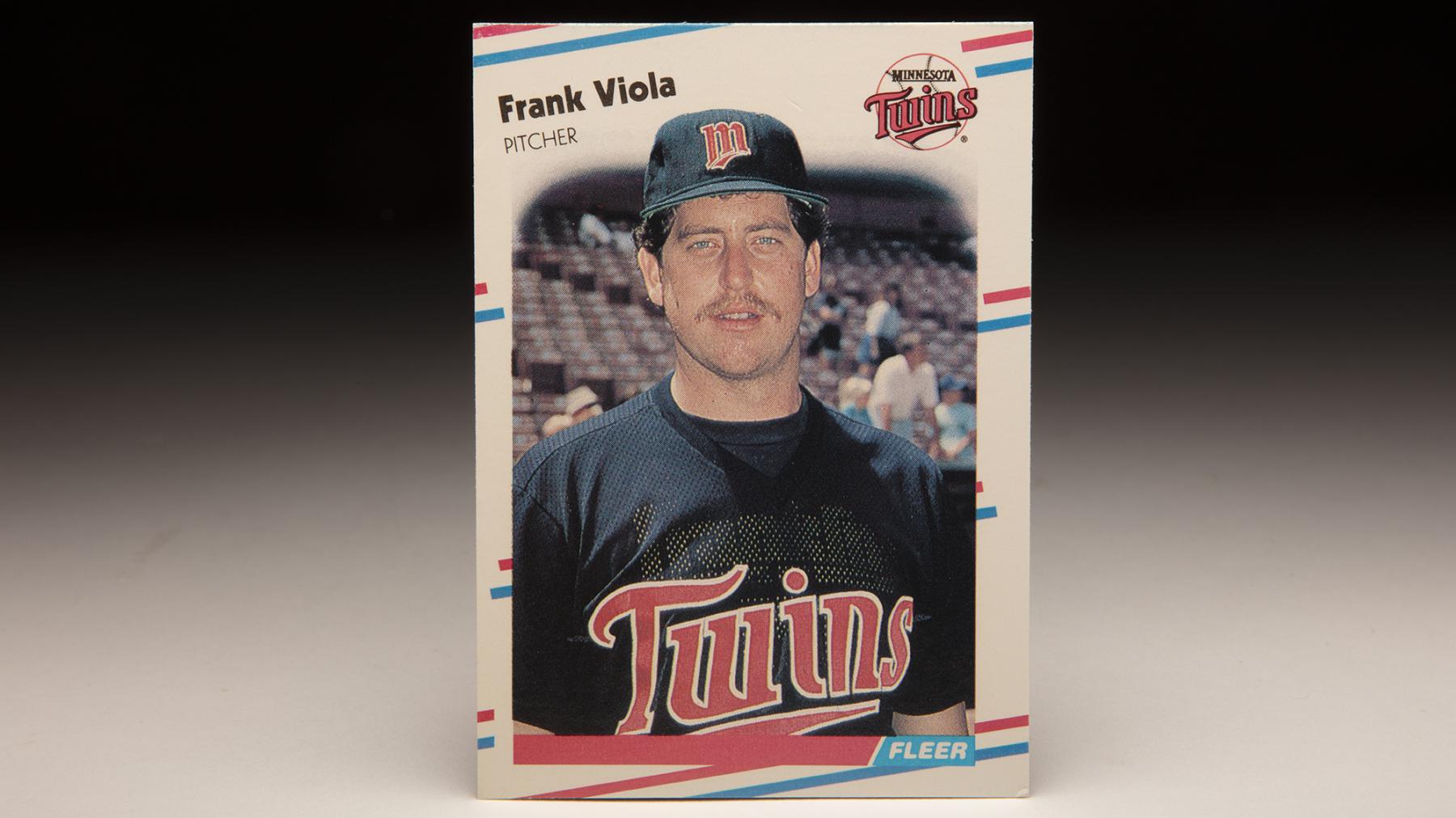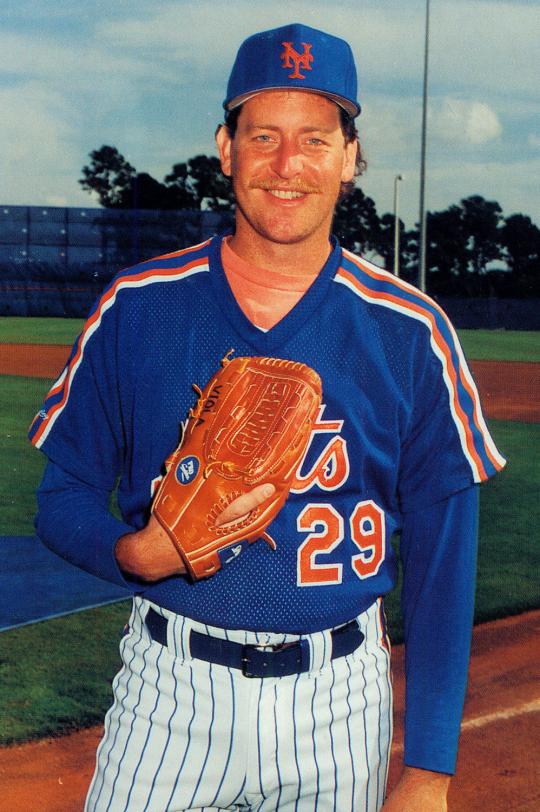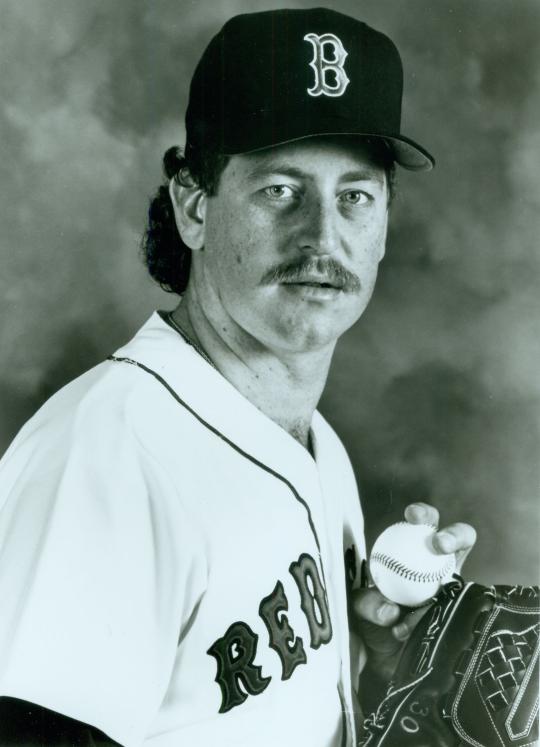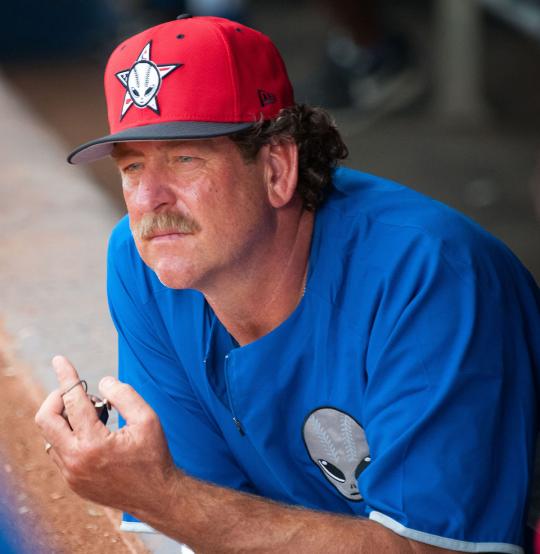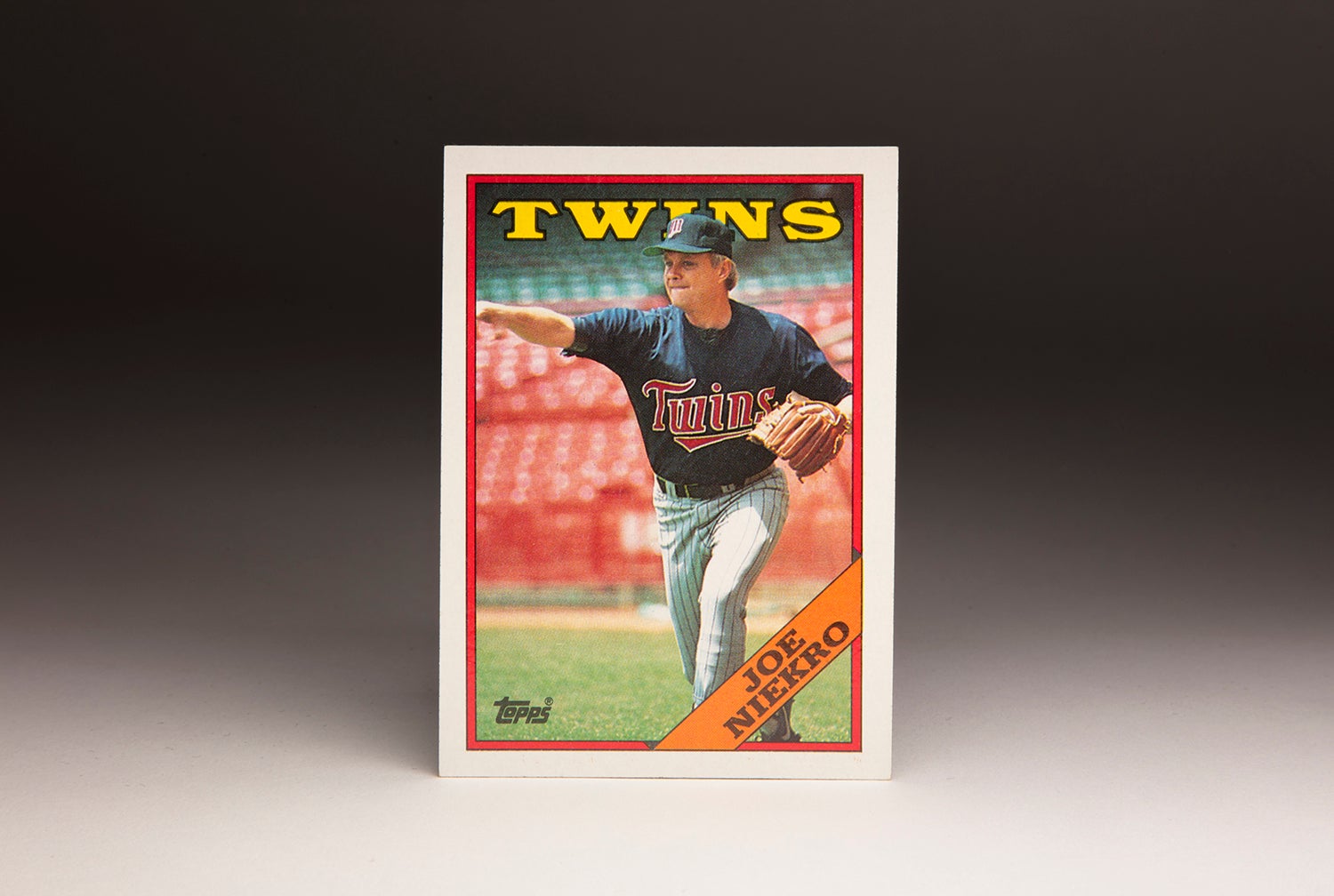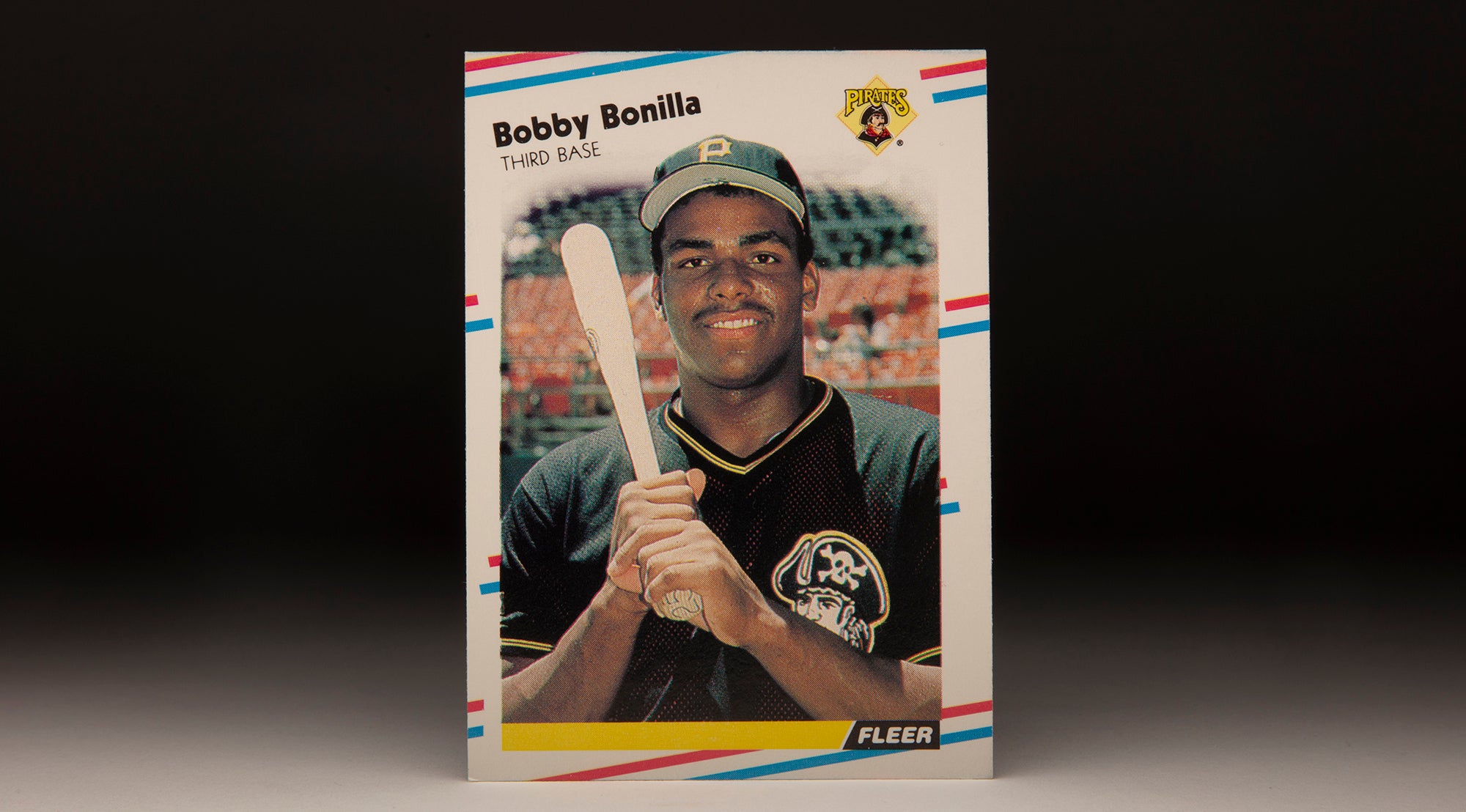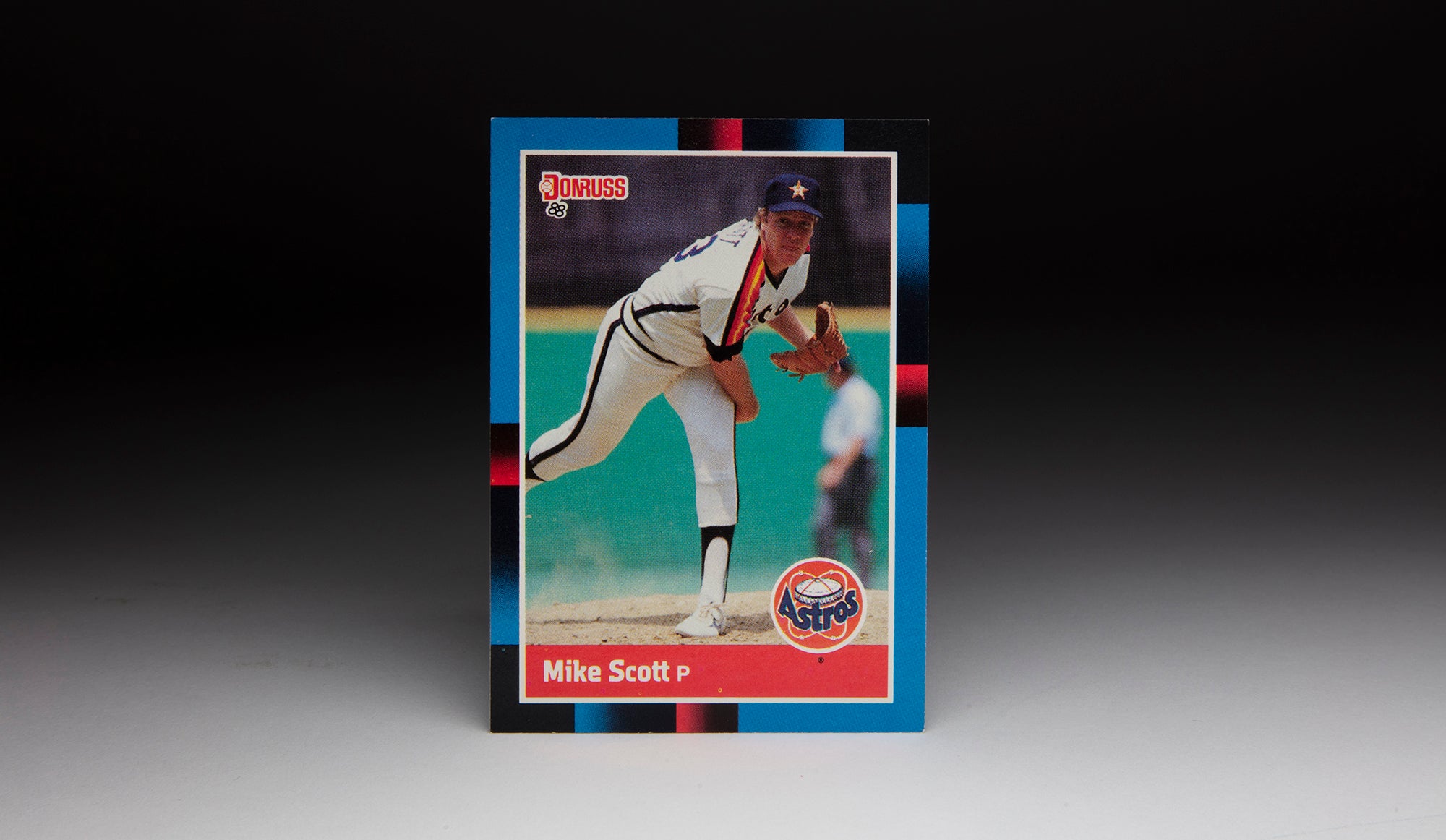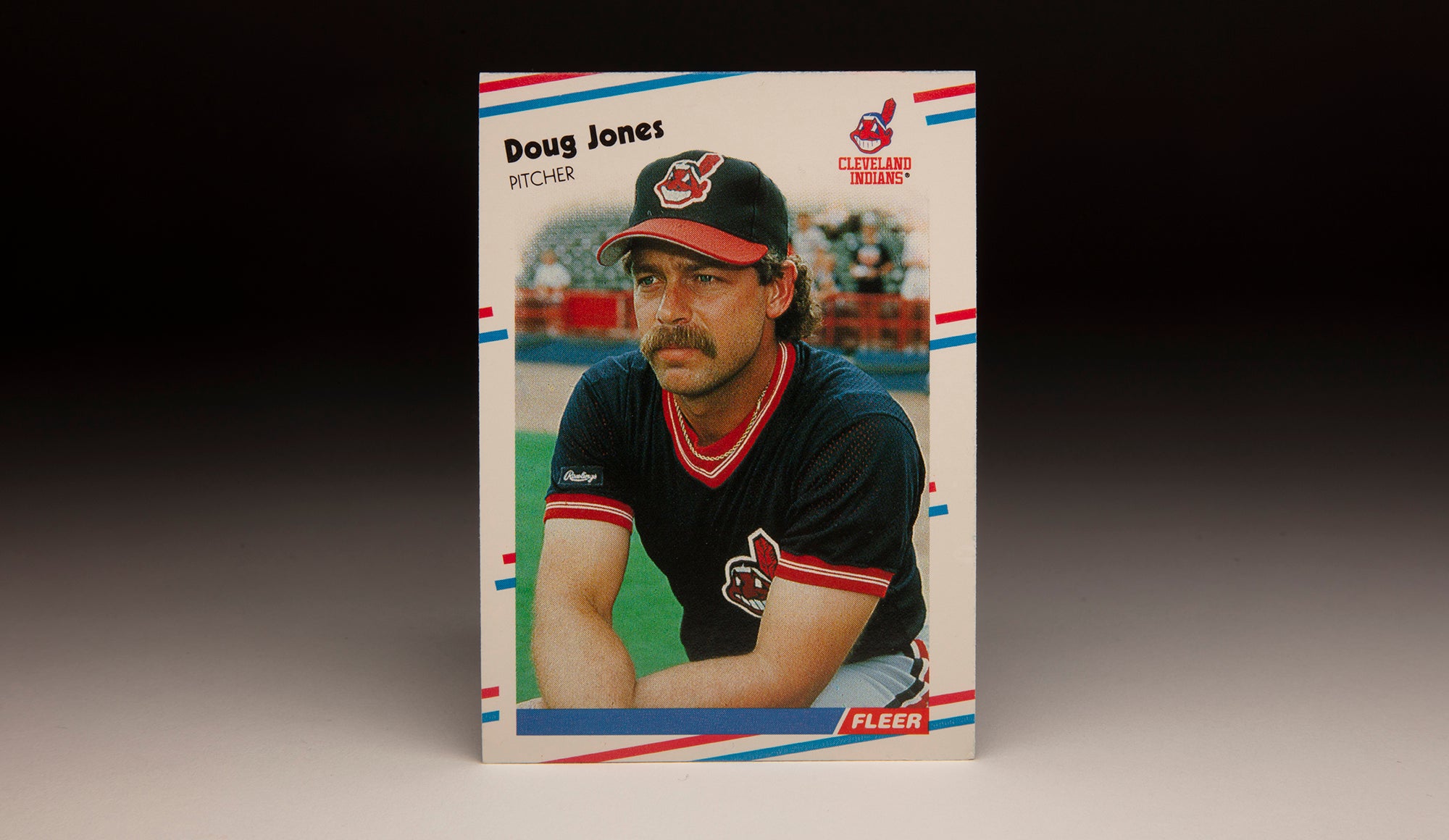- Home
- Our Stories
- #CardCorner: 1988 Fleer Frank Viola
#CardCorner: 1988 Fleer Frank Viola
In the days before pitch counts dominated the game, ace pitchers would be routinely lined up to work three games of a seven-game World Series.
Left-hander Frank Viola fulfilled that role for the Minnesota Twins in 1987, leading the franchise to its first World Series title with an MVP performance in the Fall Classic.
It was part of a two-year stretch that saw Viola become one of the top pitchers in the game.
Official Hall of Fame Merchandise
Hall of Fame Members receive 10% off and FREE standard shipping on all Hall of Fame online store purchases.
Born April 19, 1960, and raised on Long Island, Viola was a rail-thin first baseman throughout his youth league days. Viola was also an outstanding basketball player who might have had a collegiate future on the court.
“My dream,” Viola’s father, Frank Sr., told Newsday, “was that he’d replace (Steve) Garvey at first base for the Dodgers.”
But during his junior year at East Meadow High School, Viola was tabbed for an emergency start by coach Mike Kostynick when the scheduled pitcher was unable to go.
“I think we were playing Massapequa,” Viola told Newsday.
Over the next two seasons, Viola won 15 of his 18 decisions – going 10-1 his senior year – and worked his way onto the radar of big league clubs, which were and remain ever-vigilant about finding left-handed pitchers. Viola was still growing into a frame that would reach 6-foot-4 and 200 pounds – and the Royals took him in the 16th round of the 1978 MLB Draft.
Viola, however, opted for a scholarship at St. John’s University in nearby Queens.
“I didn’t think I was ready then,” Viola told the New York Daily News. “I was just learning how to pitch, and St. John’s had a great pitching coach in Howie Gerschberg.
“I had the best of two worlds: I was getting a good education and having fun playing baseball at the same time.”
By his second season at St. John’s in 1980, Viola was one of the staff aces – and started St. John’s first game of the College World Series in Omaha, Neb., defeating eventual champion Arizona 6-1.
“He had a good enough fastball to keep hitters honest,” St. John’s head coach Joe Russo told the Daily News. “But he beat you with an excellent curveball and a good slider. On Frankie’s best days, he’d get 17-18 groundballs and four to five strikeouts.”
Viola teamed up with another future big league lefty, John Franco, in the St. John’s rotation, leading the team back to the College World Series in 1981. In the first game of the Northeast Regional, Viola faced another soon-to-be MLB star – Ron Darling of Yale University – in what turned out to be one of the best pitching performances in collegiate history.
Darling held St. John’s without a hit through 11 innings, but Viola blanked the Bulldogs the whole time. St. John’s finally scratched a run across in the top of the 12th – and Viola, who was lifted for a pinch-hitter during the winning rally – got the win after allowing six hits over 11 innings.
“That was the game that moved him up from, say, a 10th-round choice to a second-round pick,” Russo said. “I remember Frankie and his father telling me that he might come back to St. John’s for one more year, but I told him he had done everything he could in college and was ready for a pro career.”
The Twins selected Viola – who was 26-2 in three years at St. John’s – in the second round of the 1981 MLB Draft, gave him a reported $25,000 bonus and sent him to Double-A Orlando, where he went 5-4 with a 3.43 ERA in 17 appearances.
The Twins, who were revamping their roster, brought Viola to Spring Training in 1982.
“I was the last pitcher cut and it was hard for me to believe,” Viola told the Daily News. “I pitched terrible, awful. I guess they saw some potential help in the future.”
Viola was sent to Triple-A Toledo, where he was 2-3 with a 3.88 ERA in eight starts. On June 4, he was called up by the Twins – and Viola made his first big league start two days later, allowing three runs over 4.1 innings against the Orioles at the Metrodome.
The Twins lost that game 7-5, dropping their record to an abysmal 13-43. But over the final 106 games of the season, Minnesota went 47-59 as the youth movement began to pay dividends. Viola was 4-10 with a 5.21 ERA in 126 innings.
“In time,” Viola told the Daily News, “we’re gonna get better if they stick with this team.”
The Twins improved to 70-92 in 1983 as Viola became a rotation constant, going 7-15 with a 5.49 ERA in 34 starts. He surrendered the most earned runs (128) of any big league pitcher that year, but he gained valuable experience while learning how to pitch in the homer-friendly Metrodome.
Then in 1984, Viola took the next step – going 18-12 with a 3.21 ERA over 257.2 innings as he began to harness the circle change-up taught to him by Minnesota pitching coach Johnny Podres. The Twins finished 81-81 and Viola finished sixth in the American League Cy Young Award voting.
“Frank Viola is not the same pitcher,” fellow Twins hurler Mike Smithson told the Star Tribune in Minneapolis during the 1984 season. “There’s been a 100 percent turnaround.”
For Viola, it was simply a case of learning how to pitch in the big leagues.
“It was just a matter of – plain and simple – learning from my mistakes,” Viola said. “I took my lumps and it took more time than I would have liked, but I don’t think there’s another team that would have given me a chance to get my feet wet this way.”
Viola made his first Opening Day start in 1985 en route to an 18-14 mark with a 4.09 ERA. But the Twins slid to 77 wins as manager Billy Gardner was replaced midseason by Ray Miller, who had made his reputation as an acclaimed pitching coach. Viola made an AL-best 37 starts in 1986 en route to a 16-13 mark and 4.51 ERA. Miller, meanwhile, was fired with the Twins at 59-80 and replaced by Tom Kelly. And after Minnesota finished 71-91 and in sixth place, no one – except maybe Viola – was expecting a turnaround in 1987.
“All I’ve heard for years is about this team’s great potential,” Viola told the Star Tribune in the spring of 1987. “If we don’t make a strong effort to contend this year, part of the nucleus of this team will be broken up before next season.
“How many years are they going to go with Bruno (Tom Brunansky), Herbie (Kent Hrbek), G-Man (Gary Gaetti) and myself if we don’t win?”
It was a question that never needed answering, as the Twins won the AL West – albeit with a record of just 85-77. Viola was 17-10 with a 2.90 ERA and Bert Blyleven was 15-12, giving Kelly a solid rotation in front of newly acquired closer Jeff Reardon.
Heading into the ALCS, the Twins were heavy underdogs against the AL East champion Tigers. But Kelly called on Viola to start Game 1, and in his first postseason game he picked up the win. He permitted just one run through five innings before Detroit took a 5-4 lead in the eighth, with Viola allowing the first two runners of the inning to reach base before Reardon entered and got three flyouts – two of which produced runs.
But Minnesota scored four runs in the bottom of frame to retake the lead, leaving Viola with a no-decision after being charged with five runs in seven-plus innings. The Twins won the game 8-5.
Viola then returned to the mound three days later in Game 4 with the Twins leading the series 2-games-to-1. This time, he pitched into the sixth inning, allowing just two runs through five before the first two runners reached in the sixth – one of which scored. But Minnesota’s bullpen blanked Detroit the rest of the way in a 5-3 Twins win.
A day later, Minnesota won Game 5 to advance to the World Series.
Viola was the starter in Game 1 of the World Series – but he had planned for more than a year to be somewhere else on that date. His brother, John, scheduled his wedding ceremony for Oct. 17 – and Frank had committed to be the best man. Instead, he was facing the St. Louis Cardinals at the Metrodome.
In Game 1, Viola allowed five hits and one run over eight innings as the Twins won in a 10-1 rout. Minnesota won Game 2 by a score of 8-4 – its fourth straight postseason win on its home turf. But the Cardinals won Game 3 back in St. Louis and defeated Viola in Game 4, scoring five runs in 3.1 innings of work by the Twins’ ace in a 7-2 victory. The Cardinals then won Game 5, sending the series back to Minnesota with the Twins on the brink of elimination.
With Blyleven and Viola unavailable, Kelly turned to Les Straker, who allowed four runs in three-plus innings. But with the Twins trailing 5-2 entering the bottom of the fifth, Kirby Puckett sparked a four-run rally with a leadoff single before Gaetti doubled him home and Don Baylor followed with a home run to tie the game at 5. Steve Lombardozzi later singled home Brunansky to give the Twins a 6-5 lead that they would extend to an 11-5 victory.
Now, Viola was ready for Game 7.
Second-inning singles by Tony Peña and Steve Lake gave St. Louis a 2-0 lead, but another Lombardozzi RBI single in the bottom of the second cut the lead in half. Puckett doubled home Greg Gagne in the fifth to tie the score, and Gagne singled home Brunansky in the sixth to give Minnesota the lead.
Viola, meanwhile, got stronger as the game progressed – retiring the Cardinals in order in the top of the eighth to maintain Minnesota’s 3-2 advantage. The Twins scored an insurance run in the bottom of the eighth on Dan Gladden’s double, setting the stage for Reardon to pitch the ninth.
When the veteran closer got Willie McGee to ground out to third to end the game, the Twins were world champions.
“This is the happiest moment of my life,” Viola told the Associated Press after his eight-inning, two-run outing in Game 7 helped him earn World Series Most Valuable Player honors. “I ended the season on a much better note than if I had ended it on Game 4. I would have had a bitter taste in my mouth for a long time.”
No pitcher since Viola has started three World Series games and received a decision in every one.
With the win, Viola moved to 17-0 in games where a banner reading “Frankie ‘Sweet Music’ Viola” appeared in the outfield of the Metrodome – hung by a fan named Mark Dornfeld since the 1984 season.
“We made sure that he had tickets for the playoffs and the World Series,” Viola said.
Following the World Series, Viola agreed to a new two-year deal worth $2.9 million. Then in 1988, Viola parlayed his World Series momentum into the best regular season of his career. He went 24-7 with a 2.64 ERA, starting and winning the All-Star Game en route to the AL Cy Young Award – which he missed winning unanimously by just one vote – and a 10th-place finish in the AL MVP voting.
But the Twins and Viola could not agree on a contract extension following the season. Viola made the last of his four Opening Day starts on April 4, 1989, the same day he rejected a three-year, $7.9 million dollar offer from the team. Set to be a free agent after the 1989 season, Viola announced he would no longer discuss his contract situation and planned to leave Minnesota as soon as possible.
“Tuesday (April 4) is over,” Viola told the Associated Press. “It was the worst day of my life and it’s over.”
However, Viola soon agreed to the Twins’ standing offer. But the turmoil did not subside.
Viola was 8-12 with a 3.79 ERA when the Twins traded him to the Mets on July 31 in exchange for a huge package of prospects that included Rick Aguilera, Kevin Tapani and David West.
“A lot of people are going to ask the question: ‘Are you mortgaging the future?’” Mets vice president Joe McIlvain told Newsday. “We would never make the deal if we thought we were mortgaging the future.
“Tough times demand tough decisions and tough solutions. We’re trying to win the pennant. Plus, we got one of the best pitchers in baseball.”
The Mets, coming off an NL East title in 1988, finished second to the Cardinals in 1989 as Viola went 5-5 with a 3.38 ERA in 12 starts in August and September. But with Viola joining a rotation that already included Dwight Gooden, Sid Fernandez, David Cone, Bob Ojeda and Darling – and a bullpen that featured Franco as the closer – the Mets were widely regarded as favorites to win the National League pennant in 1990.
Viola did his part, going 20-12 with a 2.67 ERA in an NL-best 249.2 innings. But a slow start cost manager Davey Johnson his job, and the Mets finished four games back of first-place Pittsburgh in the division.
Then in 1991, the Mets struggled to a 77-84 mark as Viola went 13-15 with a 3.97 ERA, closing the season with a 2-10 mark in his final 12 decisions. But the campaign marked his ninth straight season with at least 34 starts, and he hit the free agent market at age 31 as one of the most coveted arms available.
On Jan. 2, 1992, the Red Sox signed Viola to a three-year deal worth a reported $13.9 million.
“When I first came up in 1982, I thought I’d be a Minnesota Twin for life. I really did,” Viola told the Boston Globe in Spring Training of 1992. “I feel fortunate, in my situation, to come to a club like Boston.”
Viola was 13-12 with a 3.44 ERA in 35 starts in 1992, teaming with Roger Clemens to give the Red Sox a formidable front-of-the-rotation pair. But Boston had problems with the rest of its starters and finished at the bottom in the AL East with a 73-89 record – the Red Sox’s first last-place finish since 1932.
In 1993, Viola missed the first big league start of his career in May due to an ankle injury, then began developing stiffness in his pitching elbow in August. He finished the season with an 11-8 record and 3.14 ERA but made only 29 starts, his fewest since his rookie season in 1982.
Then in 1994, Viola made five starts in April before exiting his May 3 outing against the Mariners after only 2.2 innings. Two weeks later, Dr. Frank Jobe reconstructed Viola’s ulna collateral ligament in his left arm via Tommy John surgery – ending Viola’s season.
A free agent again, Viola signed a minor league deal with the Blue Jays on April 24, 1995 – two days before the start of that strike-shortened season. But Viola did not appear in a game for Toronto and was released on July 25 after appearing in three games with Class A Dunedin.
He hooked on with the Reds a few days later and made three starts late in the season as Cincinnati made its way toward the NL Central title, going 0-1 with a 6.28 ERA. Returning to Toronto for the 1996 campaign, Viola was 1-3 with a 7.71 ERA in six early-season starts before being released on June 5.
In November, Viola officially retired.
“I’ve had almost 14 years of the best time in my life,” Viola told the Star Tribune. “No offers came along (after being released by the Blue Jays), and I decided it was time to go. I didn’t want to just hang on.”
In 421 big league appearances – all but one of them as a starter – Viola was 176-150 with a 3.73 ERA and 1,844 strikeouts. The self-effacing Viola would likely never have admitted it, but for a period of time in the late 1980s he was likely the most effective left-hander in baseball.
“One thing I don’t like is the people who treat you like something special,” Viola told the New York Times News Service in 1988. “I’m Frank Viola, and that’s who I am. All I’m doing is playing a kid’s game. Nothing special in that.”
Craig Muder is the director of communications for the National Baseball Hall of Fame and Museum

